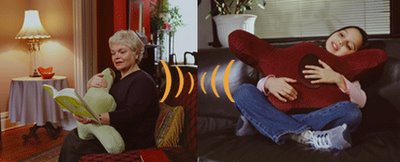If you’re new here, you may want to subscribe to my RSS feed to receive the latest Architectradure’s articles in your reader or via email. Thanks for visiting!

What if objects that people carry with them and even carry on them could offer this sensory comfort that they seem to seek?
Together with Yas I have codevelopped a touch-sensitive apparel for massage and sensory therapy. The research focuses on the material – how the structure and the embedded components of the garment participate in pushing its function to become an envelope or cocoon for one’s well-being.
Touch·Sensitive is a haptic apparel that allows massage therapy to be diffused, customized and controlled by people while on the move. Made of modular garments, it applies personalized stimuli. Touch·Sensitive aims to provide individuals with a sensory cocoon, a comforting and alerting apparel with a feedback system. Our design for the Touch·Sensitive apparel comes from the observation that people need to sooth their body to protect themselves from everyday aggressions. Touch·Sensitive is a matrix made of clothing elements that allows diffusion of tactile information through heat sensors, mechanically-driven textural sensation and liquid diffusion.
The following is a series of our Low-Fidelity prototypes.
LOW-FIDELITY PROTOTYPE #1

This wired apparel alerts the user by mechanically shrinking the fabric onto specific points of tensions on the body.
LOW-FIDELITY PROTOTYPE #2

The second low-fidelity prototype of Touch·Sensitive is made of buttons with silicone.
LOW-FIDELITY PROTOTYPE #3

Manually inflatable vinyl pockets can be used to receive a comforting pressure
LOW-FIDELITY PROTOTYPE #4

Structure flex
Touch·Sensitive allows the diffusion of tactile information through computational and mechanical technologies. It is a computerized touch therapy apparel whose modular pieces can be integrated within the clothing. We have taken advantage of the growing miniaturization of computational components to integrate them seamlessly within the fabric.
Keep tuned!
——————————————————-
Touch · Sensitive Apparel work-in-progress 6 pages paper has been accepted to CHI 2007. Come see Yas and I in Saint Jose from April 28-May 3 2007!
Abstract
Touch·Sensitive is a haptic apparel that allows massage therapy to be diffused, customized and controlled by people while on the move. It provides individuals with a sensory cocoon. Made of modular garments, Touch·Sensitive applies personalized stimuli. We present the design process and a series of low fidelity prototypes that lead us to the Touch·Sensitive Apparel.

Download pdf of the paper
 The Hug is A visionary robotic product concept developped by Carl DiSalvo, Carl DiSalvo, Francine Gemperle, Willy Yonkers, Elliott Montgomery, and Jamie Divine.
The Hug is A visionary robotic product concept developped by Carl DiSalvo, Carl DiSalvo, Francine Gemperle, Willy Yonkers, Elliott Montgomery, and Jamie Divine.
















